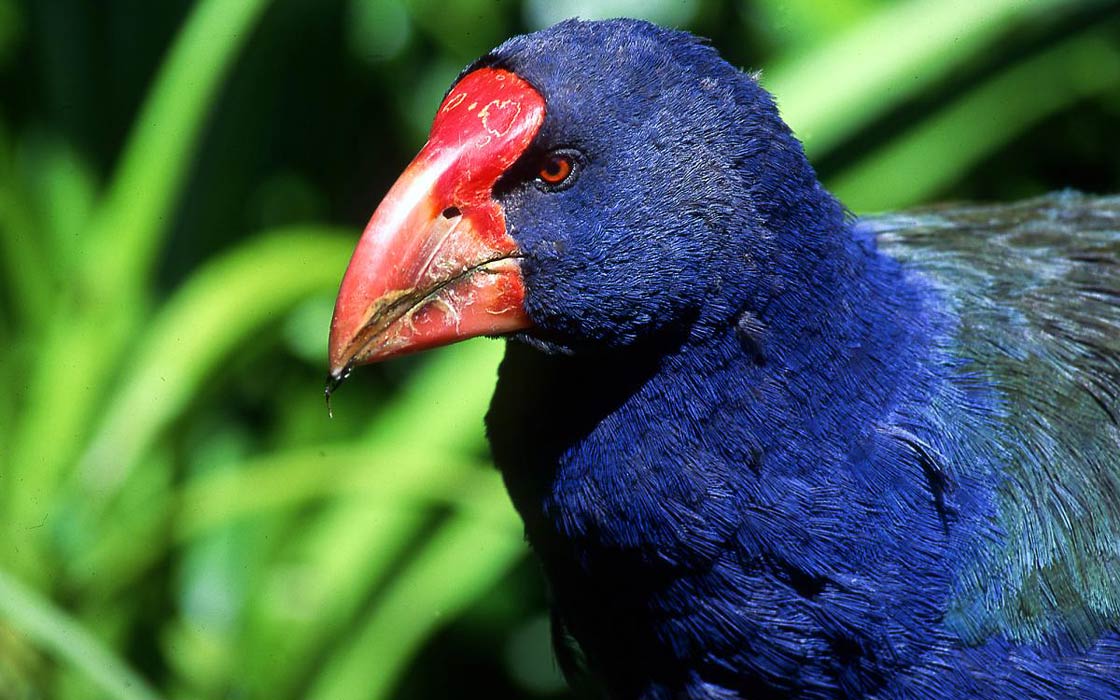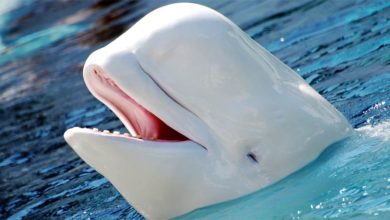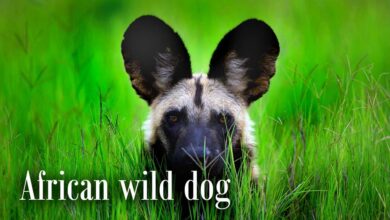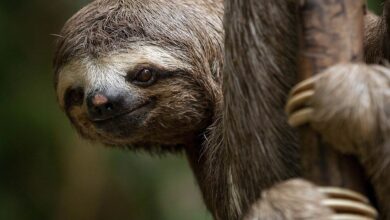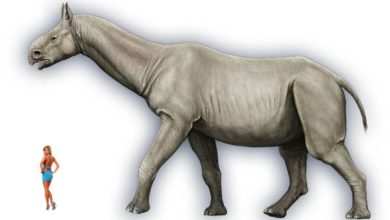South and North Island Takahē
Takahē: The Flightless Marvel of New Zealand
Deep in the rugged and enchanting wilderness of New Zealand’s South Island, a remarkable bird roams the misty mountains and verdant valleys, defying the odds and inspiring wonder. Meet the South Island takahē (Porphyrio hochstetteri), a species once thought extinct but now making a remarkable comeback from the brink of oblivion. With its vibrant blue plumage, robust beak, and endearing waddle, the takahē captivates all who encounter it, embodying both the resilience of nature and the power of human conservation efforts. Join us on a journey into the fascinating world of this majestic bird, and discover the secrets of its remarkable survival story.
The South Island takahē (Porphyrio hochstetteri) is a large and unique bird species that captures the imagination of many who encounter it. With an average length of 63 cm (24.8 in) and weight ranging from 1.8-4.2 kg (4-9.3 lb), this bird is the largest living member of the Rallidae family, which includes rails, coots, and gallinules. The takahē’s striking blue plumage, robust beak, and sturdy legs make it a distinctive and impressive creature. These birds can live up to 18 years in the wild and up to 22 years in animal sanctuaries, where they are protected from predators and other threats.
Despite its size, the South Island takahē is a skilled runner and can move surprisingly quickly through its mountainous and forested habitat. These birds are herbivorous, feeding primarily on tussock grasses and other plant material. In recent years, conservation efforts have been successful in increasing the takahē population, with the goal of establishing a self-sustaining population of over 500 birds. With its resilience and unique characteristics, the South Island takahē remains a captivating and important species in New Zealand’s natural world.
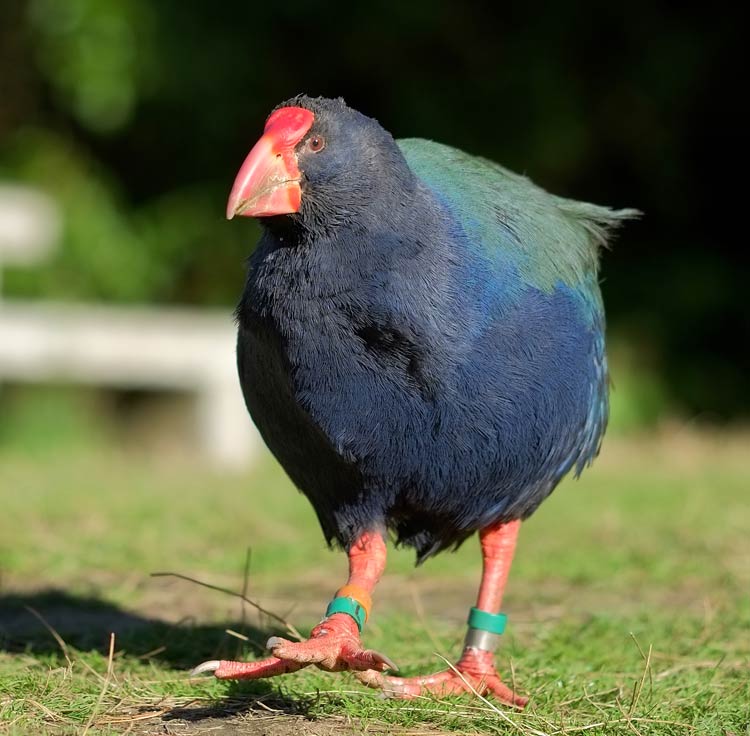
Taxonomy
The taxonomy of the South Island takahē (Porphyrio hochstetteri) has undergone several changes over the years. Originally, there were two species of Notornis birds in New Zealand, Notornis mantelli mantelli on the North Island and Notornis mantelli hochstetteri on the South Island. However, they were later reclassified as subspecies of Porphyrio mantelli, which is closely related to the Australasian swamphen or pūkeko (Porphyrio porphyrio).
Scientific classification
- Kingdom: Animalia
- Phylum: Chordata
- Class: Aves
- Order: Gruiformes
- Family: Rallidae
- Genus: Porphyrio
- Species: Porphyrio hochstetteri
Further studies using morphological and genetic evidence revealed that the North and South Island takahēs were separate species, as originally proposed by Meyer. The North Island species, known as mōho to the Māori people, is now extinct and only known from skeletal remains and one possible specimen. The mōho were taller and more slender than the takahē and share a common ancestor with living pūkeko.
On the other hand, the South Island takahē can trace its ancestry back to a different lineage of Porphyrio porphyrio, possibly from Africa. They represent a separate and earlier invasion of New Zealand by swamphens, which subsequently evolved large size and flightlessness. Overall, the taxonomy of the South Island takahē highlights its unique evolutionary history and distinct genetic lineage within the Porphyrio genus.
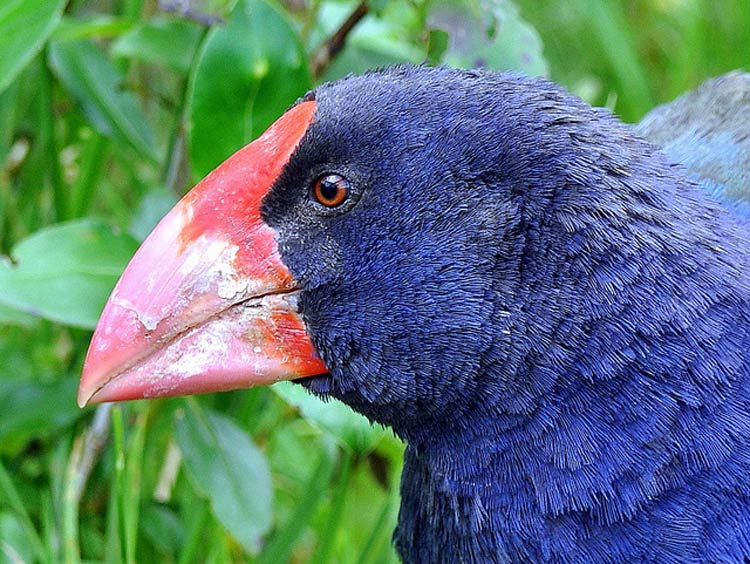
Basic Facts About Takahē
- The takahē is a flightless bird native to New Zealand, specifically the alpine grasslands and tussock meadows of the South Island.
- It is the largest living member of the family Rallidae, with an average length of 63 cm and an average weight of 2.7 kg in males and 2.3 kg in females.
- Takahēs have dark blue-green feathers, a bright red beak, and pink legs.
- They are herbivores, feeding on a variety of plant species, including tussock grasses, sedges, and herbs.
- Takahēs are monogamous and mate for life. They typically lay 1-3 eggs per year, and both parents take turns incubating the eggs and caring for the young.
- The population of takahēs declined dramatically in the 20th century due to habitat loss, hunting, and introduced predators such as stoats, rats, and ferrets.
- In the 1940s, takahēs were thought to be extinct until a small population was discovered in the Murchison Mountains of Fiordland in 1948.
- Conservation efforts, including predator control and captive breeding programs, have helped increase the takahē population in recent years. As of 2023, the population stands at around 450 individuals.
- The takahē is an important cultural and ecological symbol for the people of New Zealand, and efforts to conserve and protect this species continue to be a priority for conservationists and policymakers.
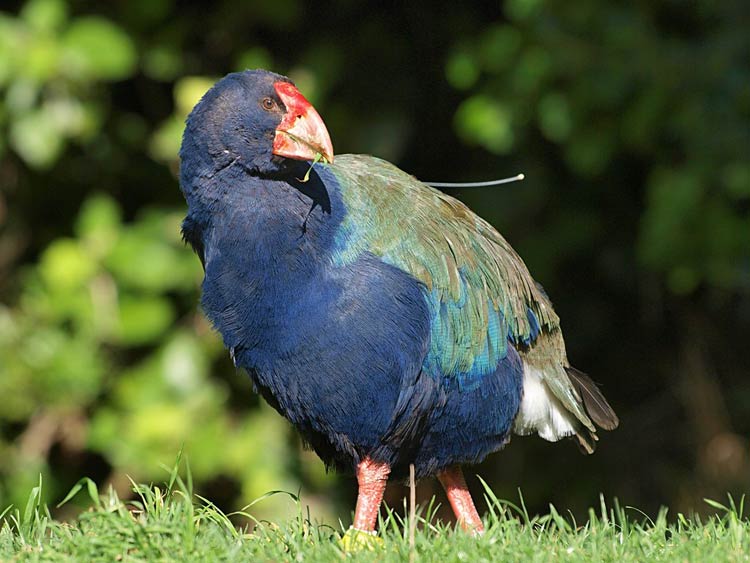
Distribution and habitat
- The South Island takahē is native to New Zealand, specifically the alpine grasslands and tussock meadows of the South Island.
- Historically, takahēs were found throughout the South Island, but their range was greatly reduced due to habitat loss, hunting, and introduced predators such as stoats, rats, and ferrets.
- Today, takahē populations are primarily found in a few isolated mountain ranges and offshore islands, including the Murchison Mountains in Fiordland, the Arthur’s Pass National Park, and the Kahurangi National Park.
- Takahēs are adapted to living in subalpine and alpine environments, typically above 900 meters in elevation. They prefer open grassy areas with access to water and shelter.
- They feed on a variety of plant species, including tussock grasses, sedges, and herbs, and will often dig up roots and tubers to supplement their diet during the winter months.
- The takahē is an important cultural and ecological symbol for the people of New Zealand, and efforts to conserve and protect this species and its habitat continue to be a priority for conservationists and policymakers. Conservation efforts have focused on predator control, habitat restoration, and captive breeding programs to help increase the population of this endangered bird.
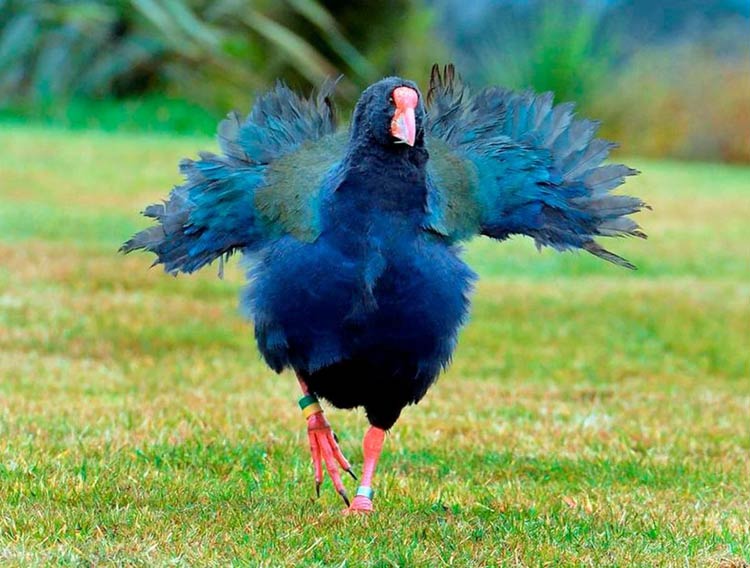
Characteristics
Appearance and size
- The South Island takahē is the largest living member of the family Rallidae. It has a stocky build, short wings, and a long, sturdy bill.
- Its overall length averages 63 cm (24.8 in) and its average weight is about 2.7 kg (5.95 lb) in males and 2.3 kg (5.07 lb) in females, ranging from 1.8–4.2 kg (3.97-9.26 lb).
- Takahēs have a distinctive blue-green plumage on their head and upper parts, with a bright red bill and shield. Their underparts are a deep blue-purple color.
- They have short wings that are not capable of sustained flight, and their strong legs and feet are adapted for walking and running on rough terrain.
- Males and females look similar, although males are slightly larger and have a more prominent shield on their bill.
- Takahē chicks have fluffy black down when they hatch, which is replaced by dark brown feathers after a few weeks. They reach full adult plumage at around six months of age.
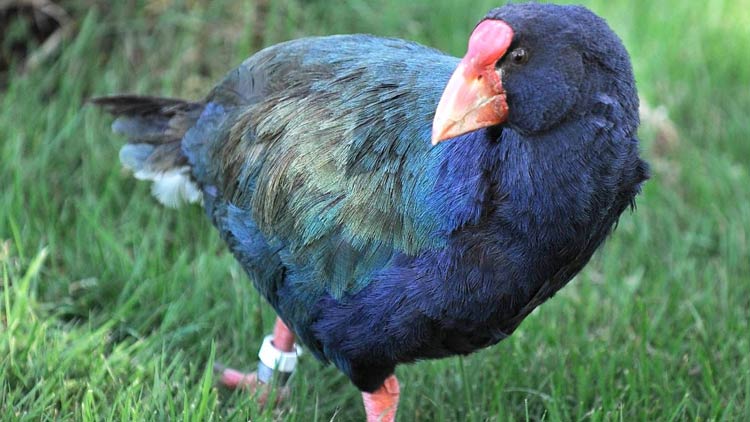
Behavior, Lifestyle and Ecology
- The South Island takahē is a social bird and is often found in small groups or pairs. They communicate with each other using a range of vocalizations, including grunts, whistles, and croaks.
- Takahēs are predominantly herbivorous, feeding on a range of plant material including grasses, sedges, and ferns. They have a unique digestive system that allows them to extract more nutrients from their food than other bird species.
- They are active during the day and spend much of their time foraging for food on the ground, using their strong legs and feet to walk or run over rough terrain.
- Takahēs are monogamous and mate for life. Breeding pairs will build a nest together, usually in dense vegetation, and take turns incubating the eggs and feeding the chicks.
- They are a long-lived species, with a lifespan of up to 18 years in the wild and up to 22 years in captivity.
- Takahēs are an important part of New Zealand’s ecosystem and play a vital role in maintaining the health of wetland habitats. They are also culturally significant to the Māori people of New Zealand, who have long held the bird in high regard.
- Takahēs are currently classified as endangered, with a population of around 450 individuals, all of which are closely monitored and managed through conservation programs. The main threats to the species include habitat loss, predation by introduced mammals, and disease. Conservation efforts include habitat restoration, predator control, and captive breeding programs to boost population numbers.
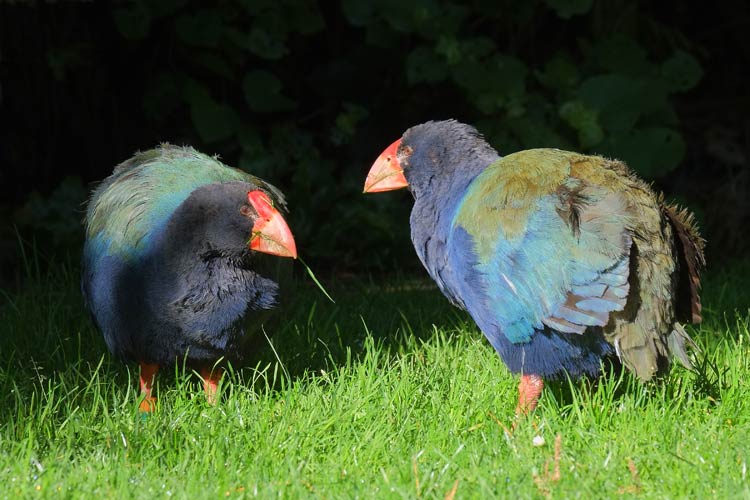
Diet
The South Island takahē (Porphyrio hochstetteri) is predominantly herbivorous, feeding on a range of plant material including grasses, sedges, and ferns. They have a unique digestive system that allows them to extract more nutrients from their food than other bird species.
Takahēs have a broad diet that includes the leaves, stems, and seeds of a range of plant species found in their wetland habitat. They are also known to consume invertebrates, such as insects and snails, but these make up only a small part of their overall diet.
Their specialized digestive system allows them to extract nutrients from tough and fibrous plant material that other bird species are unable to digest. This adaptation is thought to have evolved as a result of the harsh and nutrient-poor environment in which they live.
Takahēs are important herbivores in their ecosystem and play a vital role in maintaining the health of wetland habitats. They help to control the growth of plant species and facilitate nutrient cycling through their feeding and waste production.
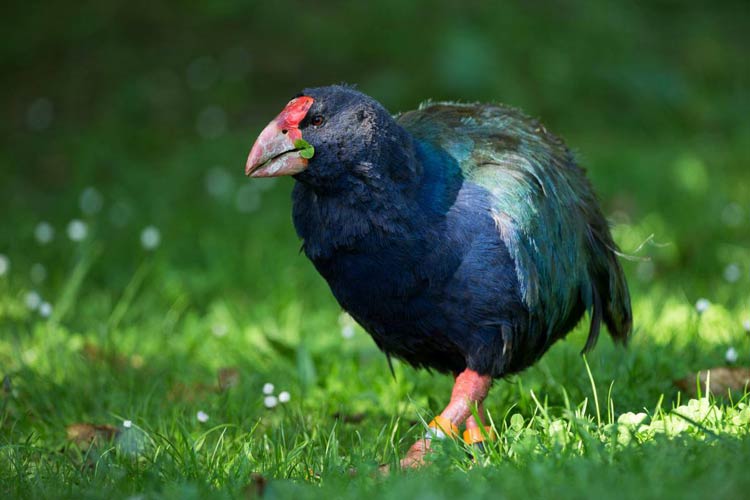
Reproduction and parenting
Takahēs are monogamous and form long-lasting pair bonds, often staying together for life. They typically breed once a year, with breeding pairs typically laying two eggs in a well-hidden ground nest made of vegetation. Both parents share incubation duties, taking turns sitting on the eggs for around 30 days until they hatch.
The chicks are born covered in a layer of down and are able to leave the nest within a day of hatching. They are cared for by both parents, who take turns feeding and protecting them. The parents will regurgitate food for the chicks, which initially feed on a mixture of semi-digested plant material and insects.
Takahē chicks grow quickly and are able to fly by around 12 weeks of age. However, they will stay with their parents for several more months, gradually becoming more independent and learning important survival skills. Once the chicks are fully independent, the parents will typically start preparing for the next breeding season. Takahēs generally reach sexual maturity at around two to three years of age, and can breed for many years if they survive to adulthood.
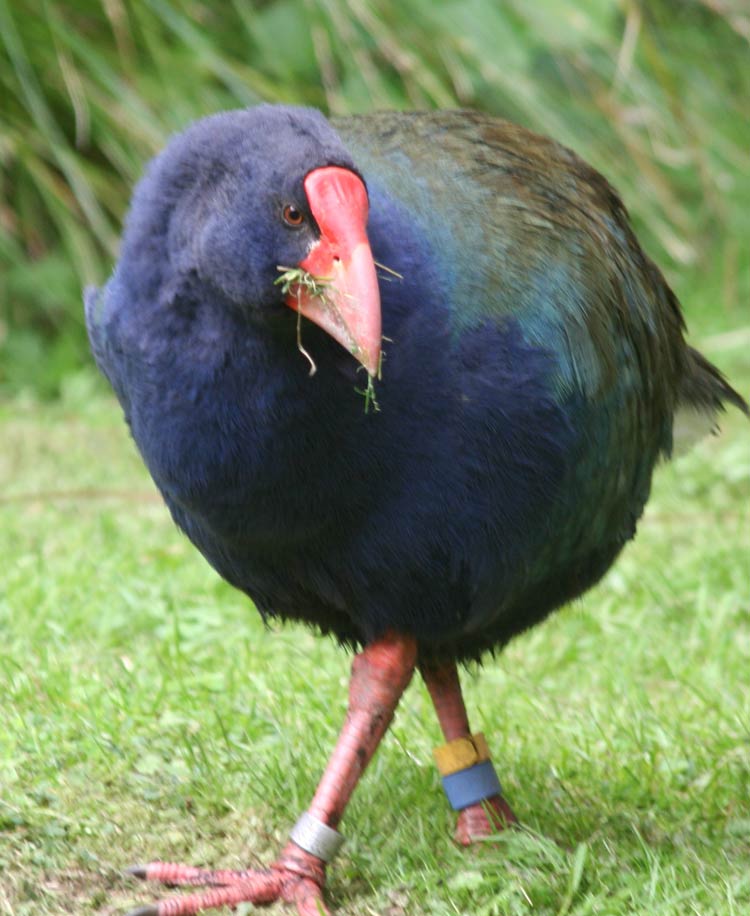
Predators and Threats
Historically, the main predators of takahēs were likely large birds of prey, such as the Haast’s eagle, which is now extinct. However, since the arrival of humans and introduced predators, takahēs have faced many more threats. Introduced predators, such as stoats, rats, and cats, are a major threat to takahēs, particularly their eggs and chicks, which are vulnerable to predation in their ground nests. Habitat loss and degradation due to human activities, such as land conversion and grazing, have also impacted takahē populations.
As a result of these threats, takahēs have experienced a dramatic decline in their population, and by the 1940s, they were believed to be extinct. However, a small population was discovered in the Murchison Mountains of Fiordland in 1948, leading to conservation efforts to protect and recover the species. Today, takahēs are still considered to be critically endangered, with only a few hundred individuals remaining in the wild. Conservation efforts, such as predator control and habitat restoration, have helped to stabilize and increase takahē populations, but ongoing efforts are needed to ensure the survival of this unique and charismatic bird.
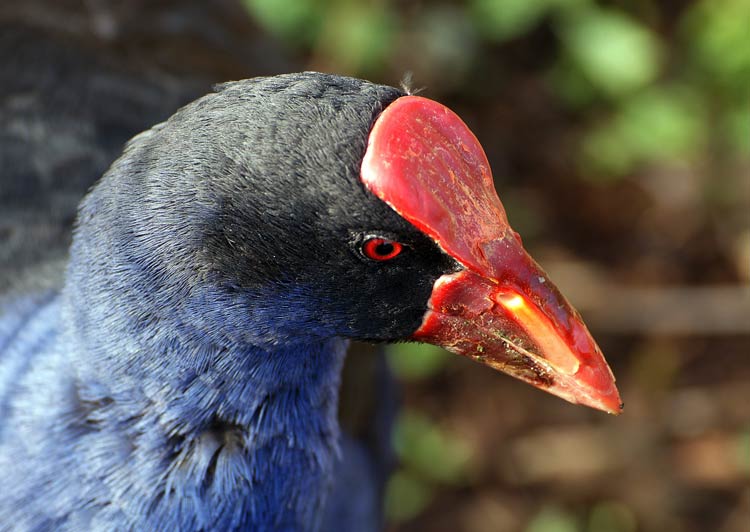
Interactions with humans
Takahēs have a special cultural and historical significance to the Māori people of New Zealand, who traditionally hunted the birds for their meat and feathers. Today, takahēs are highly valued by both Māori and non-Māori people for their cultural and ecological importance, and there are ongoing efforts to involve Māori in the conservation of the species.
Conservation efforts have been instrumental in raising awareness about takahēs and their plight, and have also provided opportunities for people to observe and learn about the birds. Takahēs are now a popular drawcard for visitors to New Zealand’s national parks and wildlife sanctuaries, and there are several facilities around the country that offer the opportunity to view takahēs in the wild or in captivity.
However, human interactions with takahēs are not always positive. In some areas, takahēs have been known to damage crops and gardens, leading to conflict with landowners. In addition, illegal hunting and disturbance of takahēs in their natural habitat remain a concern, despite legal protection for the species. Overall, it is important for people to understand the significance of takahēs and their role in New Zealand’s unique biodiversity, and to respect and support efforts to conserve and protect this rare and fascinating bird.

Population
The South Island takahē was thought to be extinct for over 50 years until it was rediscovered in 1948 in a remote and rugged area of Fiordland. Since then, conservation efforts have been undertaken to protect and increase the population of this endangered species.
As of 2021, the population of South Island takahē was estimated to be around 460 birds. This is a significant increase from just a few decades ago when the population was believed to be fewer than 100 individuals. The increase in population is attributed to successful conservation efforts, including habitat protection, predator control, and captive breeding programs.
Despite this increase in population, the South Island takahē remains a critically endangered species, and continued conservation efforts are necessary to ensure the long-term survival of the species. Efforts are ongoing to expand the range of takahēs, establish new populations, and further reduce the threat of predators such as stoats and rats.
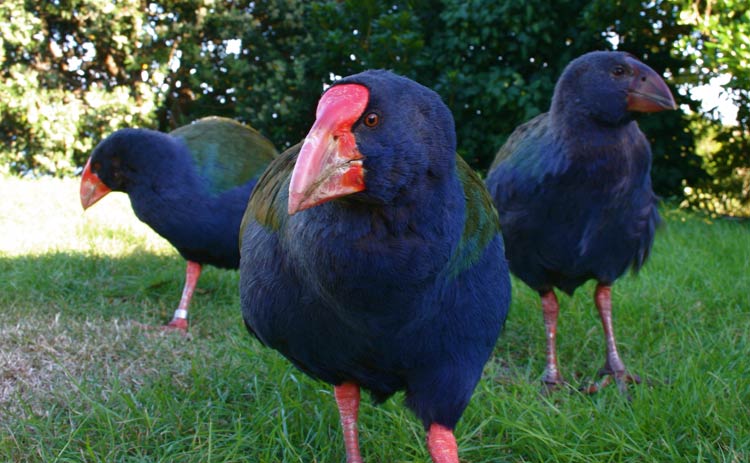
Status and conservation
The South Island takahē is listed as critically endangered by the International Union for Conservation of Nature (IUCN). The species faces many threats, including habitat loss, predation by introduced mammals such as stoats, rats, and cats, and competition for food with other introduced species such as deer and goats.
Conservation efforts for the South Island takahē have been ongoing for several decades, and have been successful in increasing the population from a low of fewer than 100 individuals to around 460 individuals today. The Department of Conservation (DOC) in New Zealand has implemented a range of management actions to support the recovery of the species, including predator control programs, captive breeding and reintroduction efforts, habitat restoration, and public awareness campaigns.
One of the most successful initiatives has been the establishment of a network of predator-free islands around New Zealand where takahēs can breed and thrive without the threat of introduced predators. The Takahē Recovery Programme, a partnership between DOC and several other organizations, has also been successful in breeding takahēs in captivity and releasing them into the wild to establish new populations.
Despite these conservation efforts, the South Island takahē remains one of the rarest birds in the world and faces ongoing threats. Continued conservation efforts and public support are critical to ensure the long-term survival of this unique and important species.

Takahē in numbers / dimensions
- Length: averages 63 cm (24.8 in)
- Weight:
- males average 2.7 kg (5.95 lb)
- females average 2.3 kg (5.07 lb)
- ranging from 1.8–4.2 kg (3.97-9.26 lb)
- Lifespan:
- 18 years in the wild
- 22 years in animal sanctuaries
- Standing height: around 50 cm (19.7 in)
- Population: as of 2023, there are around 460 South Island takahē in the world
- Conservation status: critically endangered (IUCN)
- Distribution: confined to alpine grasslands and tussocks in several protected areas in the South Island of New Zealand.
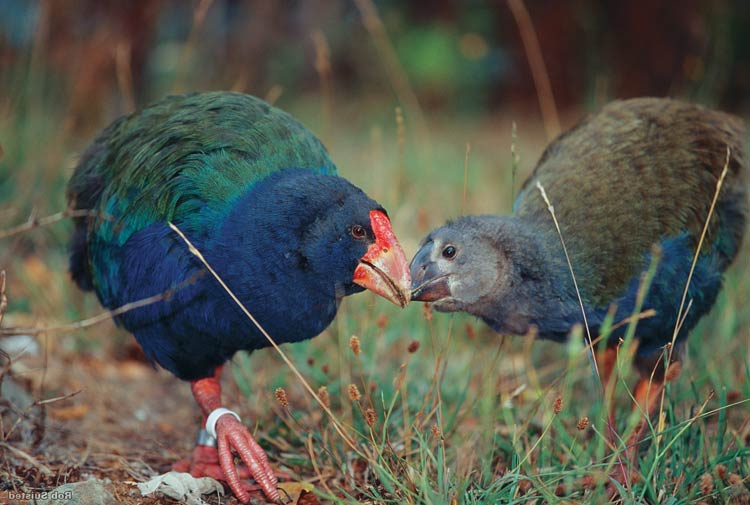
Takahē in culture
The South Island takahē holds significant cultural importance to the indigenous Māori people of New Zealand, who consider the bird to be a taonga, or treasure. In Māori mythology, the takahē is revered for its distinctive appearance, with its bright blue plumage and red beak symbolizing the sacredness of the natural world.
Takahē has also become an important symbol of conservation and environmental awareness in New Zealand. The bird was once thought to be extinct, but was rediscovered in 1948, prompting efforts to protect and preserve the remaining population. The takahē has since become a flagship species for conservation in New Zealand, and has been featured on postage stamps, coins, and various other forms of media.
The takahē has also been the subject of various art and literature in New Zealand, with many artists and writers using the bird as a symbol of the country’s unique natural heritage. In recent years, the takahē has also become a popular subject for wildlife photography and videography, with many people drawn to its striking appearance and elusive nature.

Takahē in movies
While the South Island takahē has not been featured in many movies, there have been a few documentaries that have highlighted the bird’s unique characteristics and the conservation efforts being made to protect the species.
One such documentary is “Takahē – A Bird Reborn,” which was produced by New Zealand’s Department of Conservation and aired on the Discovery Channel. The film follows the story of the takahē’s rediscovery in 1948 and the subsequent efforts to save the bird from extinction. It also showcases the work being done by conservationists to protect the takahē’s remaining habitat and increase the population of the species.
Another documentary that features the takahē is “Meet the Locals: Takahē,” which aired on New Zealand television. The film explores the bird’s unique features and characteristics, as well as the challenges it faces in its natural habitat. It also highlights the work being done by conservationists to ensure the survival of the species.
Overall, while the takahē has not been featured in many movies or mainstream media, it has become a symbol of New Zealand’s unique natural heritage and a flagship species for conservation efforts in the country.

The North Island takahē (Porphyrio mantelli)
The North Island takahē, also known as mōho, was a flightless bird that once roamed the forests and swamps of New Zealand. It was taller and more slender than its South Island relative and shared a common ancestor with the living Australasian swamphen or pūkeko. Sadly, the North Island takahē is now extinct, known only from skeletal remains and one possible specimen. Efforts to protect and conserve its close relative, the South Island takahē, continue in order to ensure the survival of this unique and endangered species.
The North Island takahē, or mōho, was a large, flightless bird that once roamed the dense forests and swamps of New Zealand’s North Island. It was similar in appearance to its South Island relative, the takahē, but was taller and more slender. The North Island takahē was first described in 1873 by Richard Owen, who named it Notornis mantelli after Walter Mantell, a New Zealand politician and naturalist. However, it was later reclassified as a subspecies of the takahē and named Porphyrio mantelli. The Māori people knew the bird as mōho and hunted it for food and feathers.
Sadly, the North Island takahē is now extinct. The last confirmed sighting of a live bird was in 1898, although unconfirmed reports persisted until the early 20th century. Like its South Island relative, the North Island takahē was hunted by early European settlers for its meat and feathers, and its habitat was destroyed by land clearance and the introduction of non-native animals such as stoats and rats. Today, the South Island takahē is the only surviving member of the takahē species and is one of the world’s rarest birds. Efforts to protect and conserve this unique and endangered species continue to this day, with the ultimate goal of ensuring its survival for future generations.

Interesting facts about Takahē
- The Takahē is a flightless bird that is endemic to New Zealand, which means it is found nowhere else in the world.
- The Takahē is one of the world’s rarest birds, with only a few hundred individuals left in the wild.
- Takahē are known for their bright, vivid blue and green feathers, which are said to be more vibrant than those of the peacock.
- The Takahē has a unique, trumpet-like call that can be heard up to a kilometer away.
- The Takahē is a herbivore that feeds on a range of vegetation, including tussock grass, leaves, and fruits.
- The Takahē is an important cultural icon for Māori, the indigenous people of New Zealand, who have many stories and legends about the bird.
- The Takahē has a distinctive breeding behavior, with both parents taking turns to incubate the eggs and care for the chicks.
- The Takahē has been the focus of intense conservation efforts in New Zealand, and its population has slowly been increasing in recent years.
- The Takahē is closely related to the pūkeko, another New Zealand bird that is also known for its colorful plumage.
- The Takahē was thought to be extinct until it was rediscovered in 1948 by a ranger named Geoffrey Orbell in the remote Murchison Mountains of Fiordland National Park.
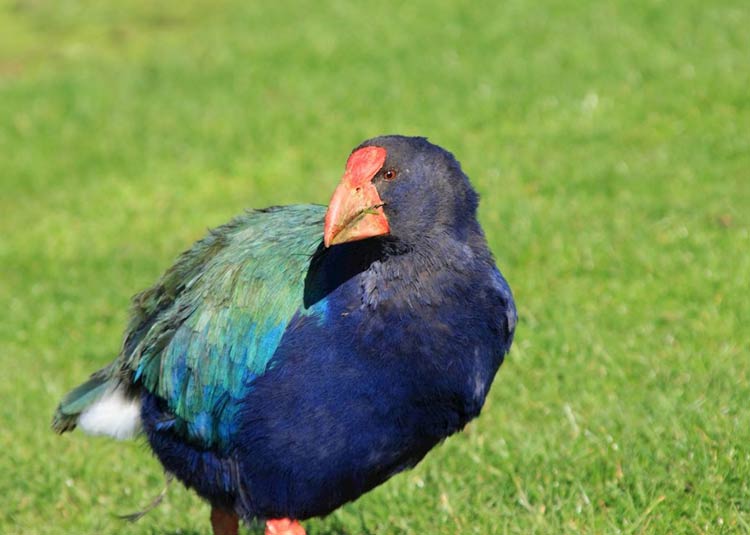
Q&A (questions and answers) about Takahē
Q: What is a Takahē?
A: Takahē (Porphyrio hochstetteri) is a flightless bird native to New Zealand, and is one of the world’s rarest and most endangered birds.
Q: What is the habitat of Takahē?
A: Takahēs live in wetlands and tussock grasslands on the South Island of New Zealand.
Q: What is the size of a Takahē?
A: The overall length of a Takahē averages around 63 cm (25 inches) and its standing height is around 50 cm (20 inches). The average weight is about 2.7 kg (6 pounds) in males and 2.3 kg (5 pounds) in females, ranging from 1.8–4.2 kg (4-9 pounds).
Q: What do Takahē eat?
A: Takahē are herbivores and primarily feed on the leaves, stems, and roots of a variety of native plants.
Q: Are Takahē flightless?
A: Yes, Takahēs are flightless birds.
Q: What is the conservation status of Takahē?
A: Takahēs are classified as “Endangered” on the IUCN Red List, and are protected under the New Zealand Wildlife Act 1953. There are ongoing conservation efforts to save the species, including captive breeding and habitat restoration programs.
Q: What is the lifespan of a Takahē?
A: The lifespan of a Takahē can range from 18 years in the wild to 22 years in animal sanctuaries.
Q: How many Takahē are left in the world?
A: As of 2023, there are 460 Takahē left in the world.
Q: What is the history of Takahē?
A: Takahē were once thought to be extinct, but were rediscovered in 1948 in the Murchison Mountains of Fiordland in New Zealand. The species was then intensively studied and conservation efforts were put in place to save the species from extinction.
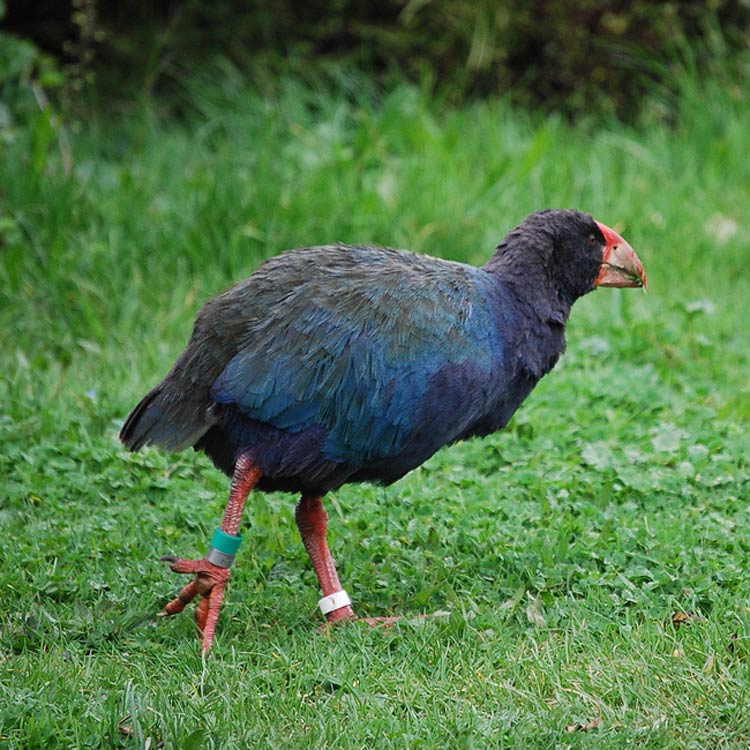
Recommended
- African lion
- Asian lion
- African elephant
- African forest elephant
- Asian elephant
- Moose
- Owls
- Parrots
- Giraffe
- Gorillas
- Zebroid
- Zebra
- Giant anteater
- Lizards
- Toucans
- Lemurs
- Secretarybird
- Ants

